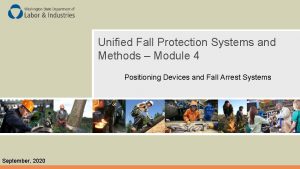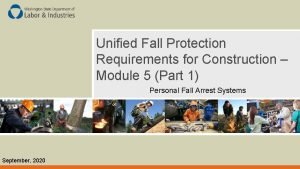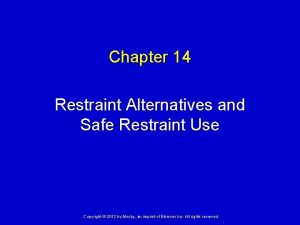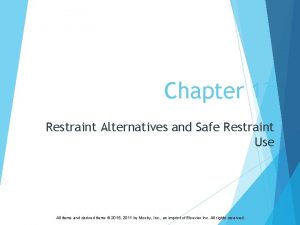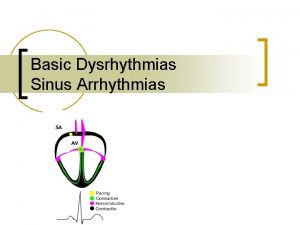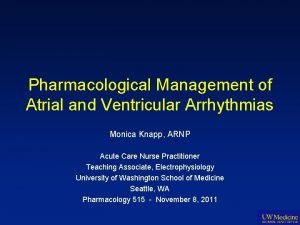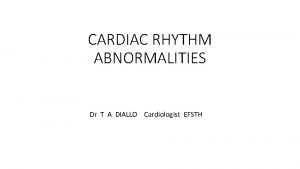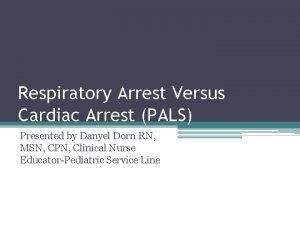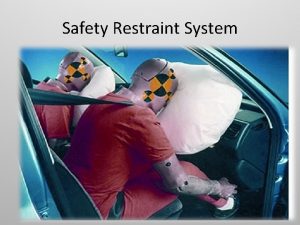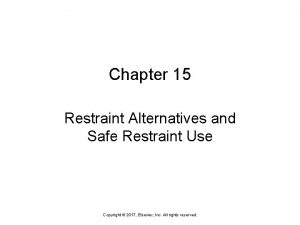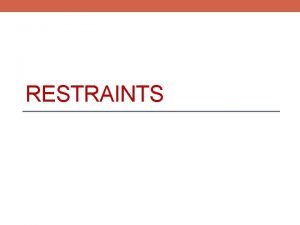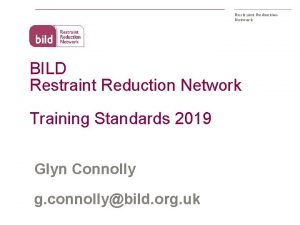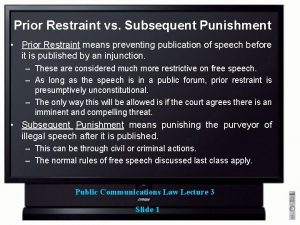Fall Protection Fall Restraint vs Fall Arrest PRESENTED
















- Slides: 16

Fall Protection Fall Restraint vs Fall Arrest PRESENTED BY

Fall Protection • Falls are the leading cause of death in the construction industry • In 2018, 338 out of 1, 008 total deaths in construction were caused by falls. That’s 33. 5%. • OSHA cited 6, 010 fall protection violations for 2019 When possible, eliminate a fall hazard through engineering controls by changing the working environment, processes and procedures.

Fall Protection Fall protection is required when: • a worker is working at a minimum height of 4 or 6 feet for general industry and construction respectively, or • a worker is working at any height where there is danger below. For example, objects that could impale the worker are below the work surface.

Fall Restraint Fall restraint prevents the worker from falling. The restraint system will allow a worker to work near a fall hazard but not reach the fall exposure. • Lanyard in personal fall arrest system (PFAS) is too short to allow them access to an unprotected leading edge • Guardrail ANSI Z 359. 0 -2007 defines fall restraint and fall restraint systems as follows: 2. 63 Fall Restraint: The technique of securing an authorized person to an anchorage using a lanyard short enough to prevent the person’s center of gravity from reaching the fall hazard. 2. 64 Fall Restraint System: A device or devices, including any necessary components, that prevents an authorized person from reaching a fall hazard.

Fall Restraint

Fall Restraint

Fall Arrest Fall arrest stops the worker after the fall preventing the worker before they contact the lower level. A fall arrest system is most appropriate when workers are working near a leading edge and their center of gravity could cross over the edge. • PFAS comprised of harness, lanyard, tie off point and deceleration device • Deceleration device absorbs force and slows worker down during a fall preventing serious injury to the worker • Must stop a fall within 6 feet or before a lower level • Prompt rescue after the fall is vital ANSI Z 359. 0 -2007 defines fall arrest and fall arrest systems as follows: 2. 51 Fall Arrest: The action or event of stopping a free fall or the instant where the downward free fall has been stopped. 2. 53 Fall Arrest System: The collection of equipment components that are configured to arrest a free fall.

Fall Arrest

Fall Arrest

Fall Restraint vs Fall Arrest Similarities: • Both are forms of active fall protection • Workers must be trained to use the system properly. • Regular maintenance must be performed to ensure the system functions properly. • Both must be used according to manufacturer recommendations. • Both must be specific to the work environment, job tasks and hazards.

Selection Companies should consider: • Job risk factors • Scope of work • Different types of protection

Safe Work Practices • Utilize JSA can aid in identifying the hazards and risks associated with job tasks • Identify and determine equipment needs. Equipment can include types of scaffolds, ladders, and safety gear. Conduct safety meetings to review safe work procedures. • Train workers • On fall hazard awareness • How to use the equipment • Staying alert, aware and prepared

Safe Work Practices Continued. . • Ensure all protruding reinforcing steel or other sharp objects, onto and into which employees could fall, are guarded to eliminate the hazard of impalement. • Cover holes • Use guardrail systems, fences, or barricades when the excavations are not readily seen to alert pedestrians and equipment operators to fall hazards • Keep work area clean to reduce slip, trip, and fall hazards

Falling Object Protection • Prevent falling objects by tethering or tying off tools and equipment when working at height • Protect against falling objects by wearing a hard hat and other necessary PPE • Avoid working under a load • Stack materials in a way to prevent them from falling, collapsing or sliding

Falling Object Protection

www. resolveok. com
 Fall protection methods
Fall protection methods Dbi sala
Dbi sala Restraint alternatives
Restraint alternatives Restraint alternatives
Restraint alternatives Amsta arrest
Amsta arrest Aakash bavishi
Aakash bavishi Ecg rhythm strip interpretation basic lesson 4
Ecg rhythm strip interpretation basic lesson 4 What options did an accused witch have in salem?
What options did an accused witch have in salem? Derin hipotermik sirkülatuar arrest
Derin hipotermik sirkülatuar arrest Sinuzal blok
Sinuzal blok Lidocaine in cardiac arrest
Lidocaine in cardiac arrest Gary goulin arrest
Gary goulin arrest Sinus pause
Sinus pause Ventriküler fibrilasyon tedavi algoritması
Ventriküler fibrilasyon tedavi algoritması Khadija diallo arrest
Khadija diallo arrest Bridget riley descending
Bridget riley descending Causes of cardiac arrest
Causes of cardiac arrest
